How to Make Green From Yellow and Blue
Green has always been a troublesome color for beginners. Why that is the case, I'm not sure. It may have something to do with a lack of understanding of how to mix color. Or maybe it has something to do with how we actually perceive green.
As Pablo Picasso once said:
They'll sell you thousands of greens. Veronese green and emerald green and cadmium green and any sort of green you like, but that particular green, never.
In any case, mixing green is no different from mixing any other colors. In this post, I am going to discuss how to mix green and in particular, how to mix a vivid green.
What Colors Make Green?
It is pretty common knowledge that yellow and blue make green. If you are not familiar with basic color mixing, then a simple way to think about it is if you mix two colors, then the color you get will usually be between those colors on the color wheel.
So if you mix yellow with blue, then you will get the color between them on the color wheel, which is green. This is a very basic explanation of how subtractive color mixing works.
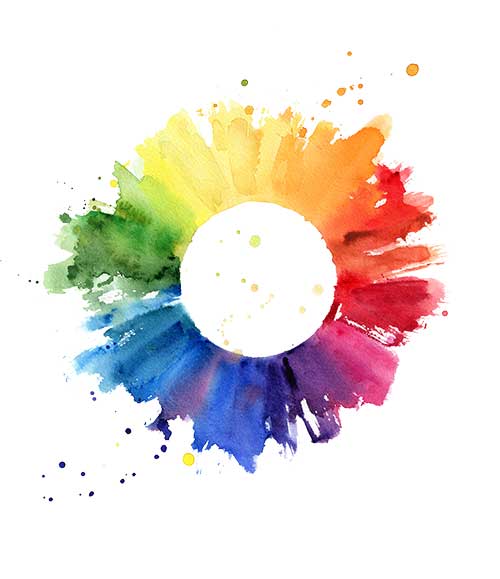
But the real question is not "what colors make green?" It is, "what type of green will you make by mixing a yellow and a blue?"
You see, as painters, we do not have an absolute yellow or blue. We have many different variations, such as ultramarine blue, cobalt blue, manganese blue, yellow ochre, cadmium yellow, cadmium yellow light, cadmium yellow deep, naples yellow, and so on.
These colors belong to either the blue or yellow families. But they each lean towards another color, that is, they have a color bias.
For example, ultramarine blue leans towards red, but manganese blue leans towards yellow.
So most of the primary colors we use on our palettes are positioned at different places on the color wheel. This is a very important concept to understand, as it determines what colors you are actually capable of mixing.
Color is not so simple that you are able to just grab any red, blue and yellow and mix all the colors of the rainbow like some color theory suggests. Color in painting is not that straightforward.
Color Bias - Cool And Warm Primary Colors

An interesting exercise you can do is to go through your studio and round up all the different reds, blues and yellows you have. Above is a photo of all the different yellows and blues I found.
These are the paints:
- Cadmium yellow light
- Naples yellow
- Cadmium yellow
- Yellow ochre
- Manganese blue
- Cobalt blue
- Ultramarine blue
So when someone asks "what colors make green?", you can see why it is a difficult question to answer. Yellow and blue is a broadly correct answer, but that does not tell us what we really want to know. There are so many different types of yellows and blues to choose from.
Each of these colors are positions at different locations on the color wheel. You could say that each of these paints are either warm or cool versions of yellow or blue. But remember, it is much more effective to think about color temperature as a relative term rather than an absolute term. So I do not like to refer to a certain yellow as being either warm or cold. I prefer to think of a yellow as being either warm or cool relative to the other yellows.
When you have a few different yellows and blues, what you can do is rank them in terms of relative color temperature.
In theory, the cooler yellows will have more blue and lean towards green. The warmer yellows will have more red and lean towards orange.
The cooler blues will have more yellow and lean towards green. The warmer blues have more red and lean towards violet.
So if I rank the yellows in terms of color temperature from cool to warm I get - cadmium yellow light, cadmium yellow, naples yellow, yellow ochre.
If I rank all the blues I get - manganese blue, cobalt blue, ultramarine blue.
Once you understand these color biases, then you will have a much easier time mixing vivid secondary colors. You see, to mix a vivid secondary color you need to mix just two primary colors together.
But what happens when you mix a warm yellow with a warm blue? Well, by doing that you are mixing a yellow and a blue which both have a touch of red in them. So you are mixing all three primary colors to some extent. What happens when you mix all three primary colors together? You get mud (when enough of each color is present).
Exercise - Mixing Different Greens
After rounding up all the different yellows and blues, I decided to do a bit of a mixing exercise to see the different greens I am able to make.
My goal is to try and mix a vivid green. This is a struggle for many artists. Most of the time your attempt at a vivid green results in something which is much closer to a dirty olive color.
The colors on my palette below are in this order: titanium white, cadmium yellow light, cadmium yellow, naples yellow, yellow ochre, manganese blue, cobalt blue and ultramarine blue.
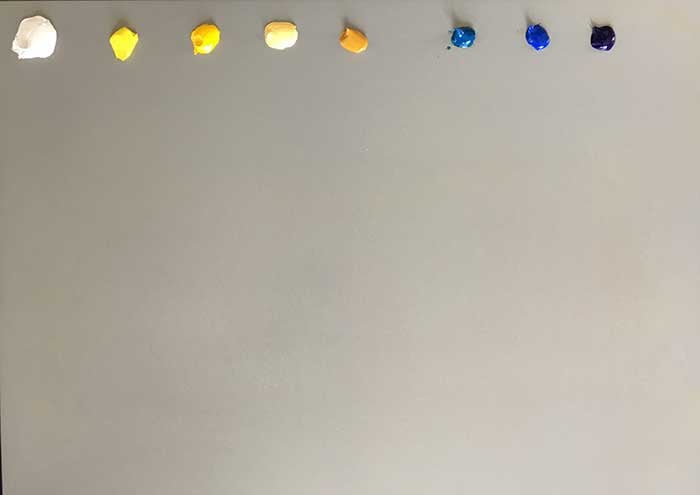
I start by mixing the most vivid green possible with the colors on my palette. To do this, I mix the coolest yellow with the coolest blue. In this case, it is cadmium yellow light and manganese blue.
These two colors are positioned closest on the color wheel compared to all other combinations of the yellows and blues on my palette. Cadmium yellow light leans towards green and so does manganese blue. Neither color contains much, if any, red.
The resulting color is a nice, vivid green.
Cadmium yellow and manganese blue also mix into a vivid green, but it is slightly warmer and less saturated.
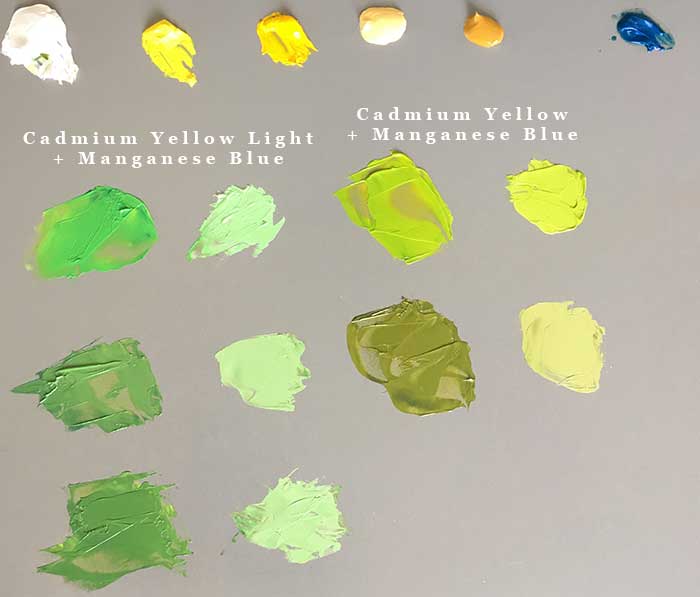
All the other color combinations are considerably less saturated. This is because more red is present in these mixtures.
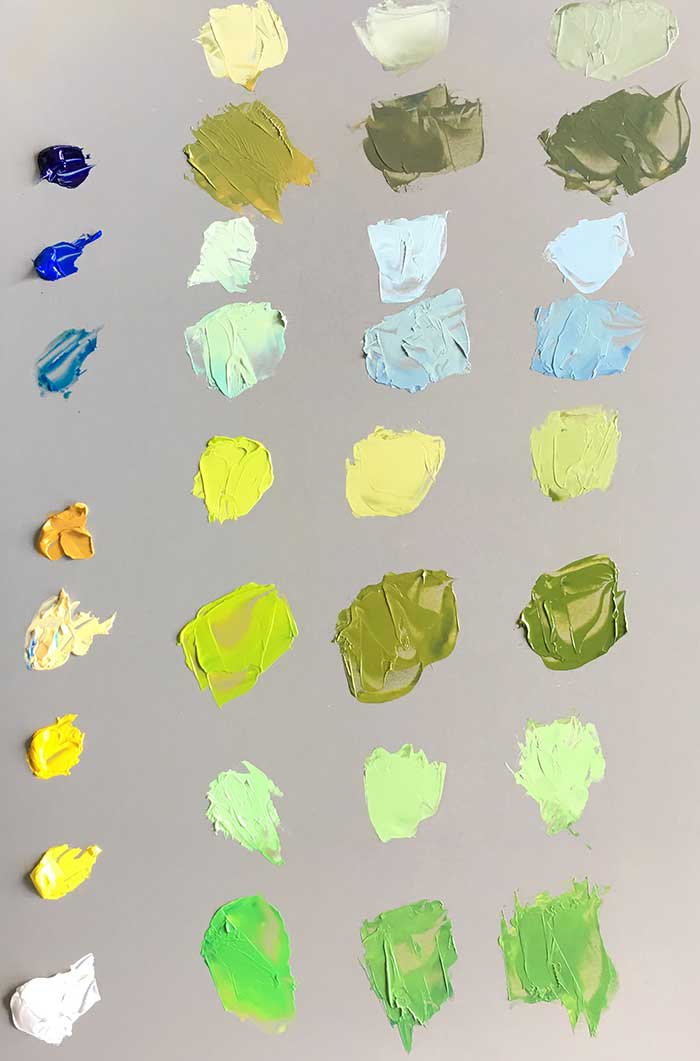
End Result - Which Colors Produced The Most Vivid Green?
Here is the most vivid green I was able to mix using the yellows and blues from my studio. I mixed this by combining cadmium yellow light and manganese blue.
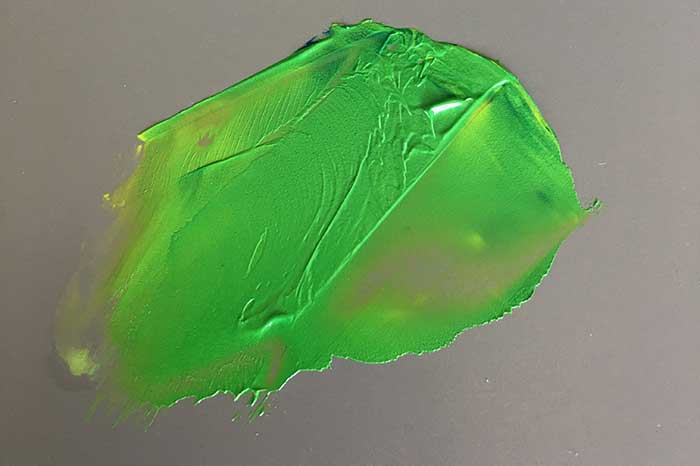
Which Colors Produced The Most Dull Green?
Not surprisingly, the dullest green was produced by mixing yellow ochre and ultramarine blue. Both these colors are relatively warm (contain some red). In addition, the yellow ochre is of low saturation.
The resulting green is almost just a gray-green.

What You Can Learn From This
The big takeaway from this post is that you need two things to mix vivid secondary colors:
First, you need two colors which have a high saturation (chroma). It seems obvious, but you are not able to mix two colors of a low saturation and somehow get a color of a higher saturation.
Second, you need to avoid mixing all three of the primary colors together. So you need to mix two primary colors which lean towards the color you want to mix on the color wheel.
Green in Practice
MyMinnippi painting was a great exercise in mixing different greens, from the dull green trees in the back to the line of bright green around the middle. You can see the painting come together in this video:
Thanks for Reading!
Thanks for taking the time to read this post. I appreciate it! Feel free to share with friends. If you want more painting tips, check out my Painting Academy course.
Happy painting!

Dan Scott
Draw Paint Academy
Source: https://drawpaintacademy.com/how-to-mix-green/
0 Response to "How to Make Green From Yellow and Blue"
Post a Comment